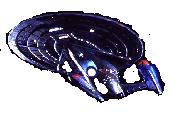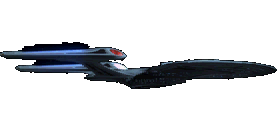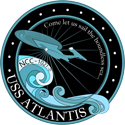 Atlantis Specs and History
Atlantis Specs and History
General Information

The USS Atlantis is one of twenty-six commissioned Sovereign Class vessels, the most notable among the others being the USS Sovereign and the USS Enterprise. The Atlantis was proof that this new class of ships would live up to and surpass all of the expectations placed upon it, for the Sovereign Class far exceeded the capabilities of Starfleet's other classes of ships. This new addition to the class expressed Starfleet's confidence in the reliability of the Sovereign Class's technological leaps in weapon, shield, and sensor technology, though several minor design changes were made between the Atlantis and the previous Sovereign Class vessels. These design changes reflected newer developments in all areas of ship construction. Atlantis's systems upped the level of reliability from the previous models of Sovereign Class vessels, illustrating that the class matured and was ready to be expanded, as it has been in the years since Atlantis's launch in 2376.

Starships Bearing the Name Atlantis
Space Shuttle Atlantis OV-104
United States Space Shuttle
Entered Service October 3, 1985
Retired from Service July 21, 2011
U.S.S. Atlantis NCC-1021-A
Excelsior Class Starship
Commissioned November 24, 2291
Refit Completed April 12, 2316
Decommissioned June 6, 2342
U.S.S. Atlantis NCC-1021-C
Galaxy Class Starship
Commissioned May 21, 2362
Destroyed at Wolf 359, Borg Conflict
U.S.S. Atlantis NCC-1021
Constitution Class Starship
Commissioned October 21, 2240
Refit Completed September 17, 2271
Decommissioned July 6, 2291
U.S.S. Atlantis NCC-1021-B
Ambassador Class Starship
Commissioned June 16, 2342
Decommissioned March 14, 2362
U.S.S. Atlantis NCC-1021-D
Sovereign Class Starship
Commissioned June 14, 2376
Refit Completed January 20, 2395
Classification: Enhanced Deterrence Explorer
Class: Sovereign
Naval Construction Contract: 1021-D
Building Site: Utopia Planitia Shipyards, Mars
Total Ship Compartments: 15,416
Ship's Compliment: 1,125 Normal, 2,056 Maximum
Computer Type: Library Computer Access and Retrieval System (LCARS)
Launch Date: Stardate 49706.14
Motto: "Come let us sail the boundless sea..."
Physical Attributes
Dimensions:
Width: 242m
Height: 94m
Mass: 3,500,000 Metric Tons
Speed:
Maximum Safe Cruising Speed: Warp 9.90
Emergency Speed: Warp 9.95
Maximum Speed: Warp 9.99 (for thirty six hours)
Destructive Speed: Warp 9.9952
Weapons:
1 x Rapid fire quantum torpedo turret + 600 torpedoes
1 x Burst fire quantum torpedo tube + 200 torpedoes
4 x Type 4 burst fire photon torpedo tubes + 280 torpedoes
Antimatter projector system
Defense:
Duranium/Tritanium double hull plus 15cm ablative armor.
High capacity structural support field
Tractor Beams: 2
Max Range: 1.24x108km
Strength Indices: (Galaxy class = 1,000)
Torpedo Firepower : 4,600
Weapon Range and Accuracy : 1,230
Shield Strength : 1,200
Hull Armor : 1,700
Speed : 3,900
Combat Maneuverability : 4,000
Overall Strength Index 2,510
Deck Layout
Deck 01: Main Bridge, Captain's Ready Room, Conference Room/Observation Lounge
Deck 02: Secondary Control Center, Main Computer Core Access
Deck 03: Impulse Drive Fusion Reactor Holding Area, Upper Sensor Dome
Deck 04: V.I.P Quarters, V.I.P. Conference Rooms 1 - 5, V.I.P. Dining Room
Deck 05: Impulse Drive Engineering, Port/Starboard Sensor Domes, V.I.P. Quarters
Deck 06: Transporter Rooms 1 & 2, Holodeck 1, Scientific Labs 1 & 2
Deck 07: Primary Brig, Main Security Office, Armory 1, Security Offices
Deck 08: Senior Officer Quarters, Senior Officer's Lounge, Senior Officer Offices
Deck 09: Holodeck 2, Fabrication Center, Transporter Rooms 3 & 4, Ship Stores
Deck 10: Forward Lounge, Chapel, Garden, Junior Officer Quarters, Ship Stores,
Deck 11: Deflector Control, Stellar Cartography, Scientific Labs 3 - 5
Deck 12: Starboard Computer Core Access, Crew Quarters, Scientific Labs 6 - 10
Deck 13: Port Computer Core Access, Crew Quarters, Crew Lounge
Deck 14: Crew Quarters, Medical Research Lab, Triage Center, EMH Computer Core
Deck 15: Sickbay, Medical Offices, Trauma Center, Surgical Xenobiology, Holodeck 3
Deck 16: Main Engineering, Chief Engineer's Office, Warp Core (8 Decks),
Deck 17: (Aft) Fighter Bay, Fighter Bay Control Center, Fighter Storage, Squadron Offices
Deck 18: (Aft) Main Shuttle Bay, Shuttle Bay Control Center, Shuttle Storage
Deck 19: Dorsal Computer Core Access, Secondary Armory
Deck 20: Maintenance Bays 1 & 2, Botanical Garden, Botanical Lab, Transporter Room 7
Deck 21: Secondary Brig, Armory 2, Emergency Systems Support
Deck 22: Storage Areas 350 - 400, Turbo Lift Maintenance, Deuterium Holding Tanks
Deck 23: Pool, Recreation Area, Auxiliary Secondary Systems Computer Core, Holodeck 5
Deck 24: Emergency Warp Ejection System, Storage Areas 400 - 470,
Command History
| June 14, 2376 – September 5, 2377: | Captain Seamus Blackthorne |
| September 12, 2377 – June 12, 2378: | Commander Earl Grey |
| June 12, 2378 – May 13, 2382: | Vice Admiral A.C. Zuriyev |
| May 13, 2382 – April 20, 2395: | Vice Admiral Ian Blackthorne |
| April 20, 2395 – December 28, 2395: | Captain Kathryn Harper |
| December 28, 2395 – June 14, 2396: | Admiral Ian Blackthorne |
| June 14, 2396 – Present: | Commodore Kathryn Harper |
Additional Notes
The origins of the Sovereign class date back as far as 2338. At this time relationships between the Federation and the Klingon Empire had degraded significantly, to the point where war was considered by many to be imminent. The President ordered Starfleet to place a design proposal for a new class of starship with much greater military capability than current designs. This project was in the advanced planning stage when the loss of the Enterprise-C during the Nerendra III incident eased tensions considerably. The warship project was initially to be scrapped, but Starfleet was instead asked to continue the project on a research basis only. Dubbed the Sovereign project, it became a theoretical Starfleet battlecruiser designed only as a computer model, with specimen hardware occasionally produced to test the design principles. The intention was to create a design that could be put into production with no delay, should a future crisis present itself.
The basic design was to be updated every five years so as to incorporate technology advances as they occurred. Initially the Sovereign design was a simple re-working of the Ambassador class, emphasizing weapons rather than exploratory and diplomatic capabilities. In the design updates of 2350, 55 and 60 much of the technology being developed for the Galaxy class project was incorporated, especially in the nacelle and warp core design. The re-establishing of relations with the Romulans in 2364 led to a major revision in the 2365 update, and many elements of the Sovereign went into low-rate production in order to establish a stockpile ready for rapid assembly.
In mid 2365 first contact was also made with the Borg. The Sovereign project was activated and construction began on the first four ships of the class. However, it was apparent that much of the Sovereign's weaponry was based on that of the Galaxy class - a vessel which had proven ineffective against the Borg during that first encounter. New weapons were in preparation for the next design update due in 2370, but these were not going to be available in the immediate future. It was clear that despite the engineers' best intentions, the Sovereign project was not going to meet its primary goal - to get a warship into service fast enough to meet the crisis now looming.
The answer Starfleet settled on was to continue construction of the hull, propulsion, computer, and sensor systems of the ships already under construction but to suspend work on the shield, phaser and photon torpedo systems for three years. Instead, a crash-development project was begun to field a small, very easily produced warship incorporating the new weapons - essentially a replay of the Sovereign project in miniature. To cut size - and therefore design and build time - to a minimum, the new vessel would only be capable of short duration missions. The vessel would be very maintenance intensive, but would carry only limited stocks of non-replicateable spares. Combined with limited accommodation standards and small fuel reserves the new class would be capable of maintaining full readiness for only six to eight weeks during independent operations, far less than had been envisaged for the Sovereign. An important secondary role of this Defiant class was as a development testbed for the technology which would be worked into the Sovereign project as soon as it was ready.
Construction continued on the Sovereigns throughout the late 2360s. With the destruction of the Borg cube in 2366, Starfleet deemed that the threat had reduced to a level which would allow the Sovereigns to enter service before any renewed offensive. The Defiant class was therefore suspended, although the prototype was put into storage rather than scrapped. The lessons learned with the Defiant were incorporated into the Sovereign when work resumed on her weapons, a process which continued after the USS Defiant was reactivated for use at DS9. The switch from photon to quantum torpedoes and the inclusion of ablative armor are prime examples of this process. In addition, the bio-neural computer system pioneered by the Intrepid class was also included. The first of the class was was launched in 2371 as the USS Sovereign, with the USS Honorious due to follow six months later. The loss of the USS Enterprise in that year led to a last-minute re-christening of the Honorious as the USS Enterprise, NCC-1701-E.
The Sovereign class has emerged from the dockyards as Starfleet's most sophisticated and comprehensively armed vessel. The vessel is equipped with a new variant of the Type XII phaser array - formerly known as the 'Type X+' for security reasons - which equips the Federation's most powerful Starbases and deep space facilities. The type twelve has a raw beam power output some 60% more powerful than the type ten arrays installed on the Galaxy class. In addition the type twelve has a shorter recharge time and can fire a longer sustained burst, giving each bank a combat effectiveness 79.4% greater than a type ten array. Since the Sovereign carries fourteen arrays compared to Galaxy's twelve, this gives the ship an overall 92.6% increase in phaser capability.
The torpedo armament is similarly impressive. The large quantum torpedo turret forward of the deflector dish is capable of firing five rounds per second, a greater overall rate of fire than the two main ten round burst photon torpedo tubes of the Galaxy class combined. Rearward quantum torpedo coverage is provided by an identical tube above the main shuttle bay. Backup to the quantum torpedoes is provided by four photon tubes; these are located at the base of the engineering section in pairs which face forward and aft and are also capable of twelve round bursts. This gives the Sovereign class the most powerful torpedo armament of any vessel in Starfleet service.
The shield system of the Sovereign class is similarly the most powerful of any Starfleet ship; the design was modified just prior to installation in order to increase effectiveness against both high energy tractor beams and phased polaron particles, measures clearly aimed at the Borg and Dominion respectively. Under normal operation the shield modulation frequencies are under the control of the ship's computer system, which continually evaluates incoming weapons fire and automatically re-modulates the shields to give the most effective possible defense. It is thought - hoped - that this system will also enable the Sovereign class shield system to prevent beam-through by Borg transporter technology.
The warp engines of the Sovereign are of a new design which eliminates subspace distortion effects inherent to standard warp drives, a feature now becoming common on most Starfleet ships. The Sovereign class is currently the fastest vessel in Starfleet, with a maximum cruise speed of Warp 9.9 and a top speed of Warp 9.99 for up to twenty four hours. The very high cruise speed is intended to allow the ship to deploy as rapidly as possible to potential trouble spots. Her impulse drive system is the most sophisticated model in production, giving the Sovereign class a maneuverability equal to that of a vessel one quarter its size.
The Sovereign's baptism of fire came in 2373 when a Borg vessel again attacked the Federation. The USS Sovereign herself was too far away to participate and the USS Enterprise - the only other Sovereign in service - was ordered to patrol the Romulan Neutral Zone rather than join the fleet engaging the Borg, a curious decision since engaging the Borg is what the ship was specifically designed for. Captain Picard disobeyed this order and joined the battle in Earth orbit, coordinating a mass strike on a weak point on the cube and destroying it. The Enterprise was subsequently pulled into the past by the Borg and almost assimilated. The crew were successful in defeating the Borg and returning to 2373.
The USS Atlantis was completed three years after this incident, and Starfleet continues to support the Sovereign Class as the premier starship of this time. Since the Atlantis was launched, twenty Sovereigns have been built, bringing the total number of Sovereigns in the fleet to twenty-six.
